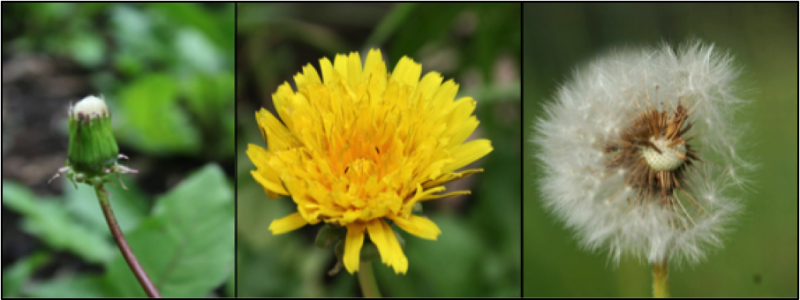
The three stages of life for a dandelion.
Wild Eats Part One: Dandelion Burgers
Some plants are so common that we forget to appreciate them. We see dandelions everywhere during the summer - their yellow flowers speckle the grass at local parks and poke out between the cracks of village sidewalks. Many people feel some hostility towards the plant, as dandelions stand in the way of a perfectly manicured lawn. Dandelions have a bad reputation, which is ironic because they were originally imported to North America for their culinary versatility and wide variety of medicinal benefits. There is no doubt that the dandelion is an invasive species, but before throwing them in your compost pile, consider exploring a new route to realize the wonders of this weed.
Dandelions (Taraxacum) are part of the Asteraceae family, and are believed to be some of the oldest plants on the planet. Fossils confirm that this species was present thirty million years ago in Eurasia. Since its first appearance, the dandelion has been used by the ancient Egyptians, Greeks and Romans, and even in Chinese herbal medicine. Dandelions have powerful diuretic, anti-inflammatory, and antioxidant properties. Many cultures have used it as a tonic to help the liver remove toxins from the body and treat a wide variety of diseases. Consuming this plant in olden times cured many vitamin deficiencies which back then killed millions of people. Dandelions became a common prescription because they could be used for conditions ranging from dandruff and rotting gums to more serious psychological disorders such as lethargy and depression.
Not only were they valued for their medicinal properties, but also in Europe and Japan these flowers were praised for their beauty, which is quite contrary to today’s perspective. The name dandelion originates from the French “dent-de-lion,” or “lion’s tooth,” because of the jagged teeth to the dandelion’s leaves. Unfortunately, the dandelion no longer holds its respected status. Dandelions were brought to North America because Europeans saw their value, but our priorities have shifted in the past century, and most adult Americans today only interact with them during the disposal process.
Many people do not realize that dandelions are actually edible and can be incorporated in many dishes. The plant is a three-tiered food since its roots, leaves, and flower buds can all be consumed. All three parts contain many health benefits, but according to wilderness survivalist Bradford Angier in his Field Guide to Edible Wild Plants, dandelion leaves contain more vitamin A than carrots, more vitamin C than tomatoes, more potassium than bananas, and even provide a higher amount of iron than spinach!
Since every part of the dandelion is edible, there are tons of different recipes involving the roots, leaves, stems, and flowers. The roots are quite succulent and can be harvested at any time. In raw form they look somewhat like a chicory or ginger. After boiling, the roots can have a pleasant taste and texture that Wild Food & Medicines describes as “surprisingly sweet.” If roasted, you can make an herbal tea or decaffeinated coffee that tastes “slightly less acidic and bitter,” according to Alexa Brue, blogger for Well+Good. The greens, on the other hand, have a short harvest window between the end of spring and start of summer because the leaves get bitter later in the year. Some people don’t mind the bitterness of late dandelion greens, but many harvesters try to pick as early as they can. Young leaves and stems are delicious in salads, sautéed with butter and garlic, or in a pesto. They taste somewhat like Swiss chard or spinach. The flowers, which provide food for birds, deer, and even bears, can also be harvested at any time. This part of the dandelion can be transformed into jellies, coffee, cookies, breads, and even burgers!
After some experimentation in the kitchen, I found that dandelion flowers are my favorite part of the weed. I tried out two different recipes with the flowers: dandelion jelly and dandelion burgers, from Langdon Cook’s awesome foraging blog, “Fat of the Land.” Both were simple and delicious, but the sheer transformation of a golden dandelion into a succulent burger made it come out on top over the jelly. Not only are the texture and flavor on point, but also the fact that you are eating something you found in nature is a fulfilling feeling. The video below includes all the steps you need to make this fun foraging recipe!
Recipe
1 cup packed dandelion petals (no greens)
1 cup flour
1 egg
1/4 cup milk
1/2 cup chopped onions
1/4 tsp salt
1/2 tsp garlic powder
1/4 tsp each basil and oregano
1/8 tsp pepper
Mix all ingredients together. The batter will be wet and goopy. Form into patties and pan fry in oil or butter, turning until crisp on both sides. Makes 4-5 very nutritious veggie burgers.
Important Note: Be careful to not harvest dandelions from areas that have been sprayed with pesticides or herbicides.
Video filmed at the TAUNY kitchen.
Comments
I'd love to try this. I
I'd love to try this. I wanted to make dandelion wine this year but I didn't want to steal the bees' food! Maybe next year!


Great video and piece- I'm totally going to try this!